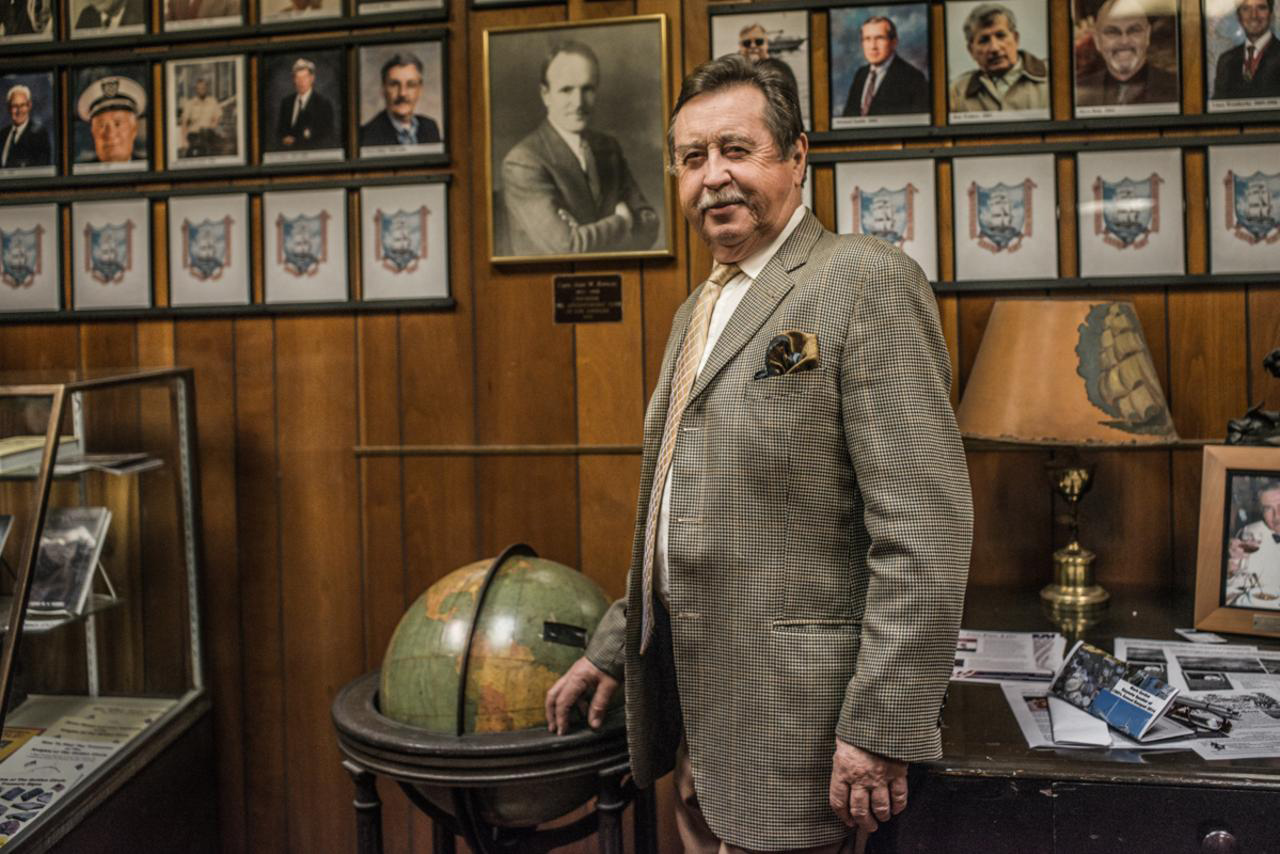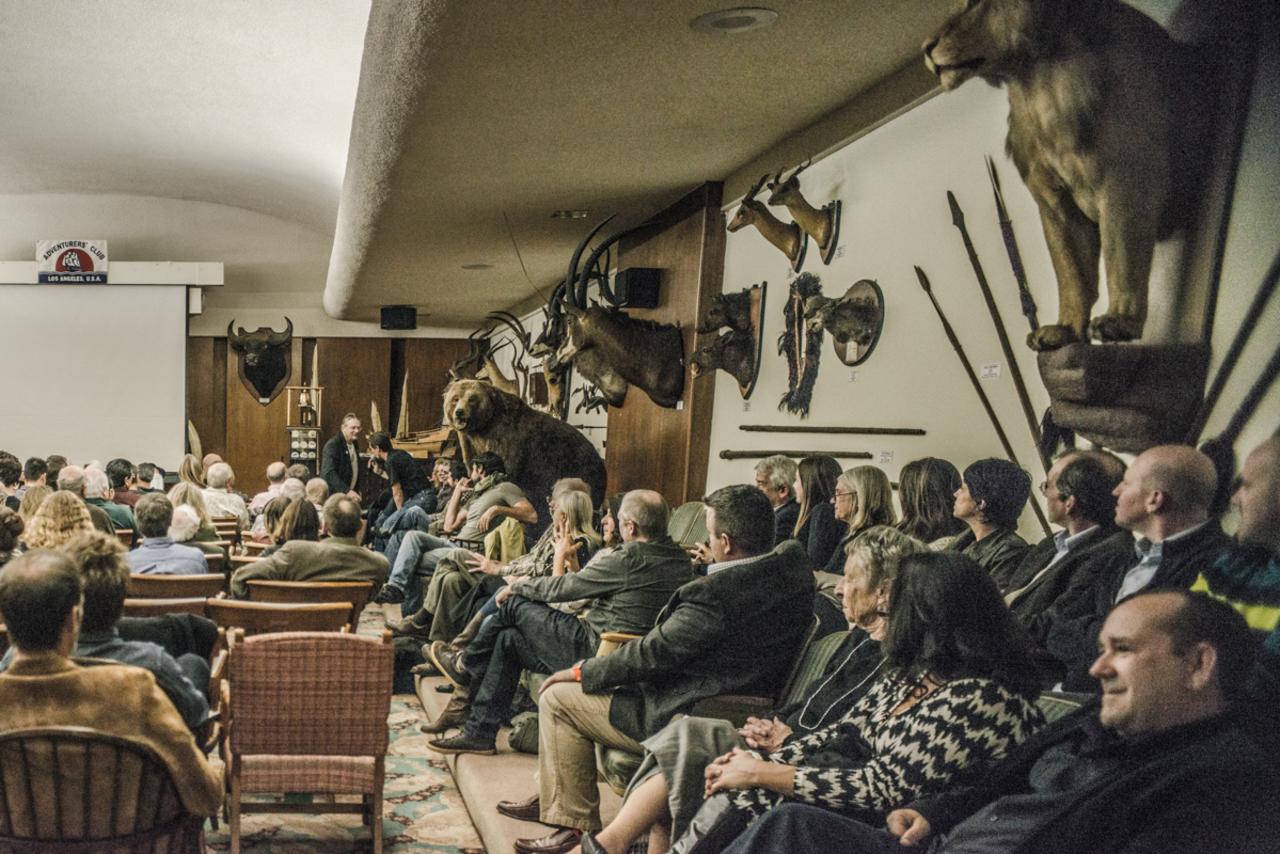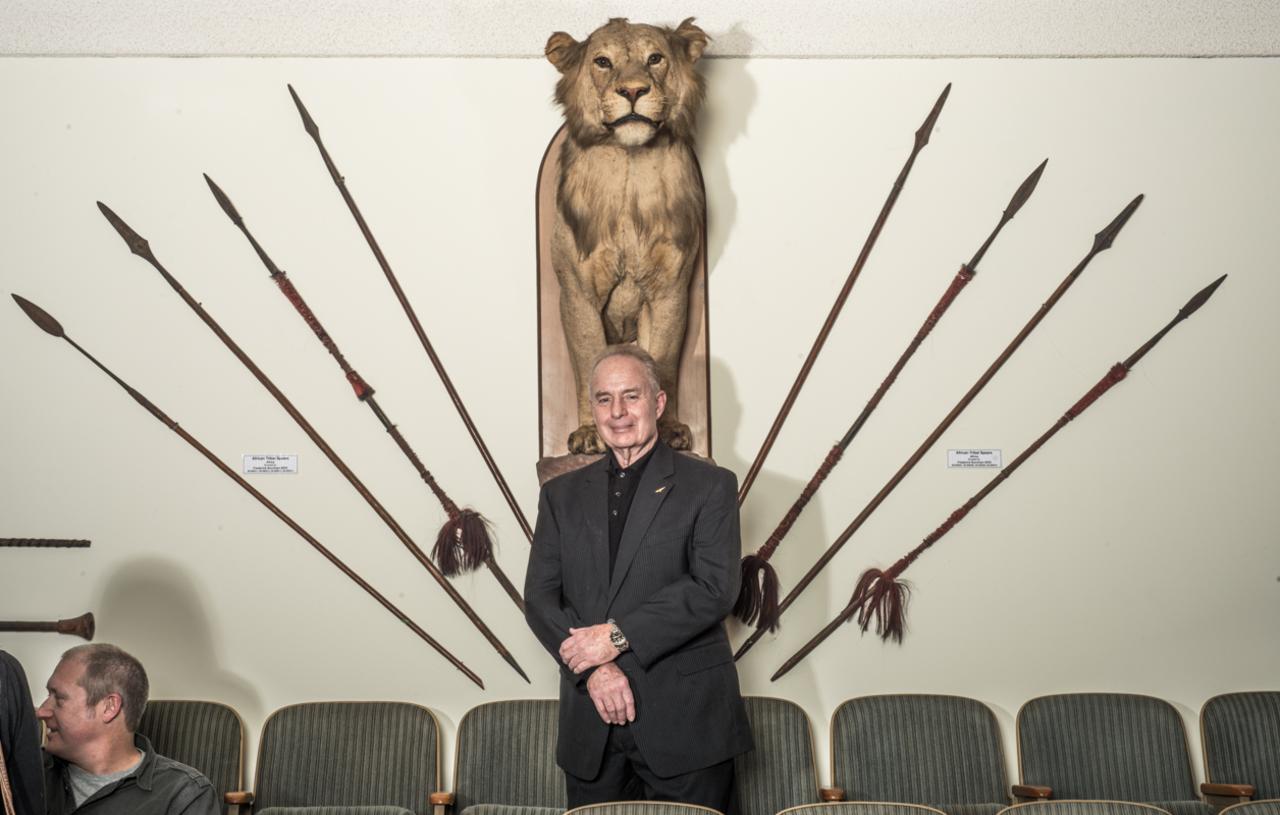The club for graying daredevils
At the Adventurers' Club, members swap tales of kayaking the Nile and circling the globe

In 1986, Dick Rutan flew with a co-pilot in a Rutan Model 76 Voyager, a custom-designed and -built aircraft, covering 26,000 air miles and taking nine days to circumnavigate the globe — unrefueled, nonstop.
After taking off from Edwards Air Force Base in Southern California, the plane headed west, making two passes over the equator, avoiding a 600-mile-wide typhoon, and doubling back over inhospitable Libyan airspace. Rutan piloted the plane without a break for the first three days of the nine-day flight. When the plane finally landed, it had a damaged wing and 1.5 percent of the fuel with which it originally departed.
Rutan's Voyager aircraft now hangs in the Smithsonian, part of an exhibit celebrating human accomplishments in flight. Once in a great while, the tanned 76-year-old will share his story, but only for those select members of the Adventurers' Club of Los Angeles. The bylaws of the club, which caps membership at 200, make it very clear that only "those who have had an unusual adventure on land, at seas, or in the air hunting, trapping, exploring, flying, or those who have attained a distinctive reputation in the field of arts, music, or science are considered eligible."
Subscribe to The Week
Escape your echo chamber. Get the facts behind the news, plus analysis from multiple perspectives.

Sign up for The Week's Free Newsletters
From our morning news briefing to a weekly Good News Newsletter, get the best of The Week delivered directly to your inbox.
From our morning news briefing to a weekly Good News Newsletter, get the best of The Week delivered directly to your inbox.
North of downtown Los Angeles, just past Chinatown in Lincoln Heights, one can easily miss the building where the Adventurers' Club meets. Absent of signage or décor, the windowless, anachronistically beige structure sits opposite a 99-cent store.
The look and feel of the club's interior could best be described as a ramshackle museum of both living and recently deceased world lore. At the top of the stairs, a massive polar bear greets visitors, posed by a taxidermist midswipe. Elsewhere, there are animal trophies from around the world: lions, gazelles, boars, even a mammoth skeleton, replete with enormous tusks. The walls are lined with chevrons, war medals, model airplanes, and wooden plaques with handsome brass nameplates holding successive etchings dating back decades.
There are photos everywhere: primarily of previous and current members clad in pith helmets, diving gear, flight suits, trapper hats, tuxedos, double-breasted blazers; an even mix of neat moustaches, full beards, and cleanly shaven faces. There are many, many maps, alongside knives, swords, spears, canoes, flags, coats of arms, portraits of sea captains and sailing ships, native adornments and jewelry, vintage pictures of airplanes, actual propellers, and at least one mannequin of a diver in chain mail.
These are the collected histories and exploits of men. The Adventurers' Club remains first and foremost a men's club, with only male members. (Though it does have a regular ladies' night, on which women are permitted to attend.)
A free daily email with the biggest news stories of the day – and the best features from TheWeek.com
The club was founded in 1921, and the core of its membership is older, many in their 60s, 70s, and 80s. Past members include Los Angeles philanthropist John Anson Ford and polar explorer Roald Amundsen. Filmmaker and explorer James Cameron is listed as esteemed member No. 1129.
Discussions of business or politics here are strictly forbidden. Embellishment of exploits is not tolerated. If you misrepresent facts about your adventures, you are likely to be humiliated by someone who traversed the geography you're attempting to embellish, and if you're discovered, you'll be quickly repudiated in front of everyone.
Despite all this, there is a jovial, warmhearted tone during Thursday-night dinners, when 20 bucks buys the guest of a member a home-cooked meal — meatloaf, rice, veggies, and apple pie à la mode on one recent evening. A can of beer goes for $2, a soda for $1. Some of the club members are pilots, surfers, documentarians, former servicemen, and commissioned officers. They carry with them war stories, obscure geographic references, a sense of momentum unhampered by age, and bucket lists bordering elite-level completion.

Ask anyone who's visited the club, and he knows Pierre's stories. Seventy-four-year-old Pierre Odier is a two-time club president who has also sat on the board of directors for 23 years. Odier speaks seven languages and estimates that he's traveled to somewhere between 160 and 170 countries.
"When I was 17, I wanted to see the pyramids, so I went to Africa," he says. "My parents were against it, but they didn't try to stop me. It started early, and I've been doing it ever since."
Most recently, he built a school in Cambodia and taught students to live off the land on the Yucatán Peninsula. His frequent travels make Odier one of the most esteemed members of the club, but his attitude is calm and welcoming. He wears a goatee, frameless glasses, and a short haircut. The tales he shares are exotic, but they are not fish tales. They feel more like reportage.
In 2010, Odier presented a talk about his adventure on Devil's Island, off the coast of French Guiana, surrounded by jags of rock and currents so strong they offer hospitality only to sharks. Odier was able to get to Devil's Island only after befriending a helicopter pilot who had responded to an emergency call in which a member of the French Foreign Legion had "cracked open his head" while carousing with friends in a recreation area on nearby St. George Island. The helicopter pilot later forgot about the planned pickup rendezvous, and Odier was forced to make camp overnight.
Ordered built by Napoleon III in 1852, the penal colony, a series of sites around French Guiana, once housed more than 70,000 French prisoners — anarchists, felons, repeat offenders — sent to the tropical wasteland amid the 19th-century European population boom and commensurate rise in crime. On average, roughly one in 10 inmates survived.
In 1938, René Belbenoît — one of a tiny handful of prisoners to escape Devil's Island — wrote a book called Dry Guillotine about the atrocious conditions on the island, which led to vast public outcry and the prison's eventual closing. Belbenoît later became a member of the Adventurers' Club of Los Angeles.
Recounting his own adventures on Devil's Island, where he was researching a small cemetery that had no official record, Odier expounded upon the importance of reading a map (a talent vanished by omnipresent smartphones) and how to bond with perfect strangers when dealing with gaping language barriers, to put them at ease. Odier's affect is decidedly disarming, owing perhaps to his Swiss origin. It seems abundantly clear, as with virtually all of the gentlemen members, he is a man of the world.
It doesn't take long to realize that every individual between these hallowed walls contains within him a library of life experience. The more senior he is, the deeper the library goes.
My first encounter with the club included a talk from Marc Weitz, an attorney who resides in downtown Los Angeles. Weitz's recent trip to Guyana, Suriname, and French Guiana placed his total number of countries at 87. Weitz showed the club photos of tropical overgrowth near Jonestown (of '70s cult lore), where he traveled through on foot; shots from inside Devil's Island; and images of the European Space Agency Launch of an Ariane rocket (only five degrees from the equator).
One of the younger adventurers at 39, Weitz had joined the rank and file of the officially adventurous six years earlier, after reading about the African exploits of John Goddard, who once kayaked the entire Nile River and later wrote a book about it. Weitz contacted the club when he heard Goddard would be presenting.
Though Weitz represents the new guard, his demographic is largely outnumbered. Without an infusion of lifeblood of new members, the Adventurers' Club is very likely to fade entirely. How many Gen Y/Millennials can tell you what an SR-71 is or understand the archetypal machismo of a man like Teddy Roosevelt? As the globe grows ever more tightly connected, the skills of individual resiliency, camaraderie, and courage that each member clearly holds dear have faded from prominence.

Inside the club's quarters, during a recent meeting, Al Enderle carried a trifolded pamphlet filled with Xeroxed copies of the story of his life. Closing in on 80, Enderle, who graduated from the U.S. Naval Academy in 1952, boasts 20-plus children, either biological or by marriage. In his life story, he recounts his experiences as a "private pilot, hang glider enthusiast, scuba diver, water skier, motorcyclist, hiker, lecturer, [and] editor at large."
His personal and professional exploits covered in the pamphlet include personally selected Bible passages, as well as a staunch commentary defending the teachings of Jesus Christ.
Another member, Gary Hareland, now in his 60s, has served 20 years in the Navy, the Coast Guard, and the Air National Guard. His first adventure came at age 11, when he hopped a passenger train, riding on the back steps of the last car from the city of San Fernando, Calif., to the Mojave Desert. Hareland has an adventure résumé heavy on verbs, with categories like "Ships I Crewed On," "Aircraft Flown," "Boats Sailed," and "Mountains Climbed."
With a tally of 39 countries under his belt, his adventuring experience came to him first in the military and then as a merchant mariner, when, following his return from service, he grew restless at his desk job.
"They had me in this little office, and I just couldn't stand it," Hareland said. "Your life is more exciting in the military. You don't know where you're going to end up."
He has since sailed for Military Sealift Command and Maersk Line, the largest shipping company in the world, with more than 20,000 employees supporting 600 vessels, the largest of which hold up to 18,000 shipping containers during one voyage. In 2004, Hareland's voyage on Norwegian Cruise Lines was thwarted when a fluke accident sank the 900-foot vessel while berthed at the Lloyd Werft Shipyard in Bremerhaven, Germany.
Officially, Hareland is a retired electronics and communications officer, but he recently applied for a communications technician position on the Titanic II, a replica of the original RMS Titanic currently being planned, financed, and built by Australian billionaire Clive Palmer. Despite Hareland's military service, international travel history, flight hours logged, and mountains climbed, he's unsure if he'll find a position on the ship.
"It's something I would really like to do," he says. "Nothing ventured, nothing gained."
Excerpted from an article that originally appeared on Narrative.ly. Reprinted with permission.
-
 Fannie Mae and Freddie Mac helped trigger the Great Recession. Would an IPO create new dangers?
Fannie Mae and Freddie Mac helped trigger the Great Recession. Would an IPO create new dangers?In the Spotlight It depends on the 'implicit guarantee'
-
 Oz at the Sphere: AI's latest conquest
Oz at the Sphere: AI's latest conquestFeature The Las Vegas Sphere is reimagining The Wizard of Oz with the help of AI
-
 Is grad school worth it?
Is grad school worth it?the explainer Determine whether the potential for better employment and higher earnings outweighs the upfront cost of school